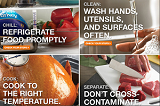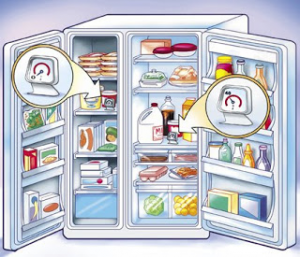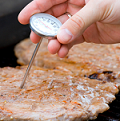Good food hygiene is essential if you intend to make, process or sell food. It is vital that you and your employees understand what good, safe food hygiene is.
 What is 'Good food hygiene'?
What is 'Good food hygiene'?
Good food hygiene is about how you control harmful bacteria, which can easily cause serious illness.
There are four things to remember when it comes to hygiene:
- Cross-contamination
- Cleaning
- Chilling
- Cooking
These are known as the 4 C's. If you remember these, you will help to prevent most safety problems.
Cross-contamination
 Cross-contamination is when bacteria are spread between difference surfaces either from the food or equipment used. It mostly happens when raw food touches cooked food, equipment of surfaces. Cross-contamination is one of the most common causes of food poisoning. To avoid giving anyone food poisoning, follow these tips:
Cross-contamination is when bacteria are spread between difference surfaces either from the food or equipment used. It mostly happens when raw food touches cooked food, equipment of surfaces. Cross-contamination is one of the most common causes of food poisoning. To avoid giving anyone food poisoning, follow these tips:
- Clean and disinfect work surfaces, chopping boards and equipment thoroughly and regularly. You should do this before you start preparing food and after you have used the equipment.
- Colour code your equipment for certain types of food. Red for raw meat, green for vegetables, blue for ready-to-eat food and white for fish.
- Always wash your hands before preparing food and wash them thoroughly after handling raw food.
- Keep raw foods and ready-to-eat foods apart at all time, including any packaging material. When storing food, keep raw foods on the bottom and ready-to-eat food above. This way the raw food will not 'drip' onto the ready-to-eat foods. Or if possible, use two fridges and keep the foods separated.
- As an employer, you should be providing separate working areas, storage facilities, clothing and staff for handling on the ready-to-eat food. Use separate machinery and equipment, such as vacuum packing machines, slicers and mincers, for raw and ready-to-eat foods.
- Individual cleaning materials such as cloths, sponges and mops should be provided for raw and ready-to-eat foods, and in areas where food is prepared, stored and handled.
All of the above will not mean a thing if your staff don't know how to avoid cross-contamination. It is your duty as an employer to teach or aid your staff about cross-contamination.
Cleaning
 Thorough and effective cleaning will get rid of bacteria on everything that you use when cooking, preparing or handling. Your hands, equipment and surfaces will need a thorough clean before and after preparing, raw and ready-to-eat food. This will help stop the spread of harmful bacteria, along with the following:
Thorough and effective cleaning will get rid of bacteria on everything that you use when cooking, preparing or handling. Your hands, equipment and surfaces will need a thorough clean before and after preparing, raw and ready-to-eat food. This will help stop the spread of harmful bacteria, along with the following:
- Ensure that all your staff are washing and drying their hands thoroughly before handling food.
- Clean and disinfect food areas and equipment between different tasks, especially after handling raw food. Clear and clean as you go, do not leave it all piled up. Clear away and wash used equipment and spilt foods, as you work. Do not let food waste build up. Empty bins regularly.
- Use cleaning and disinfection products that are suitable for the job, and follow the manufacturer's instructions. Disinfection products should meet BS EN standards. Check the product labels for ether of these two codes, BS EN 1276 or BS EN 13697.
At The Workplace Depot, we sell kitchen shelving, which is hygienic and ideal for cold rooms and freezers down to -30 degrees Celsius.
Chilling
 Chilling food properly helps stop the harmful bacteria from growing. Some foods needs to be kept chilled to keep it safe, for example, food with a 'use by' date, cooked dishes and other ready-to-eat good such as salads and desserts. It is vital that you do not leave these foods out in room temperature for long. Check and follow these points:
Chilling food properly helps stop the harmful bacteria from growing. Some foods needs to be kept chilled to keep it safe, for example, food with a 'use by' date, cooked dishes and other ready-to-eat good such as salads and desserts. It is vital that you do not leave these foods out in room temperature for long. Check and follow these points:
- Check that any chilled food being delivered is still cold enough.
- Put foods that need to be kept in a fridge away immediately.
- After you have cooked food, cool it as quickly as possible and put it in the fridge.
- If you take chilled food out of the fridge, put it back straight away during preparation.
- Regularly check that your fridge and display units are cold enough.
Cooking
 Thoroughly cooking food kills bacteria, so it is incredibly important to make sure that the food you are cooking is cooked properly. Whether your cooking or reheating food, always check that it is piping hot all the way through.
Thoroughly cooking food kills bacteria, so it is incredibly important to make sure that the food you are cooking is cooked properly. Whether your cooking or reheating food, always check that it is piping hot all the way through.
Poultry, pork, rolled meats and minced meat products (burgers and sausages) should be cooked thoroughly as the bacteria is mixed in and is in the centre of the product. Other cuts of meat from beef and lamb such as, steaks, cutlets and whole joints can be cooked to pink/rare as long as they are completely cooked on the outside.
The reason for this is, the bacteria on lamb and beef is on the outside of the piece of meat which obviously needs cooking off. If you mince the meat, you are spreading the bacteria all over the product.
For more information about food hygiene, see the Food Standards Agency website
Posted in News, Health and Safety